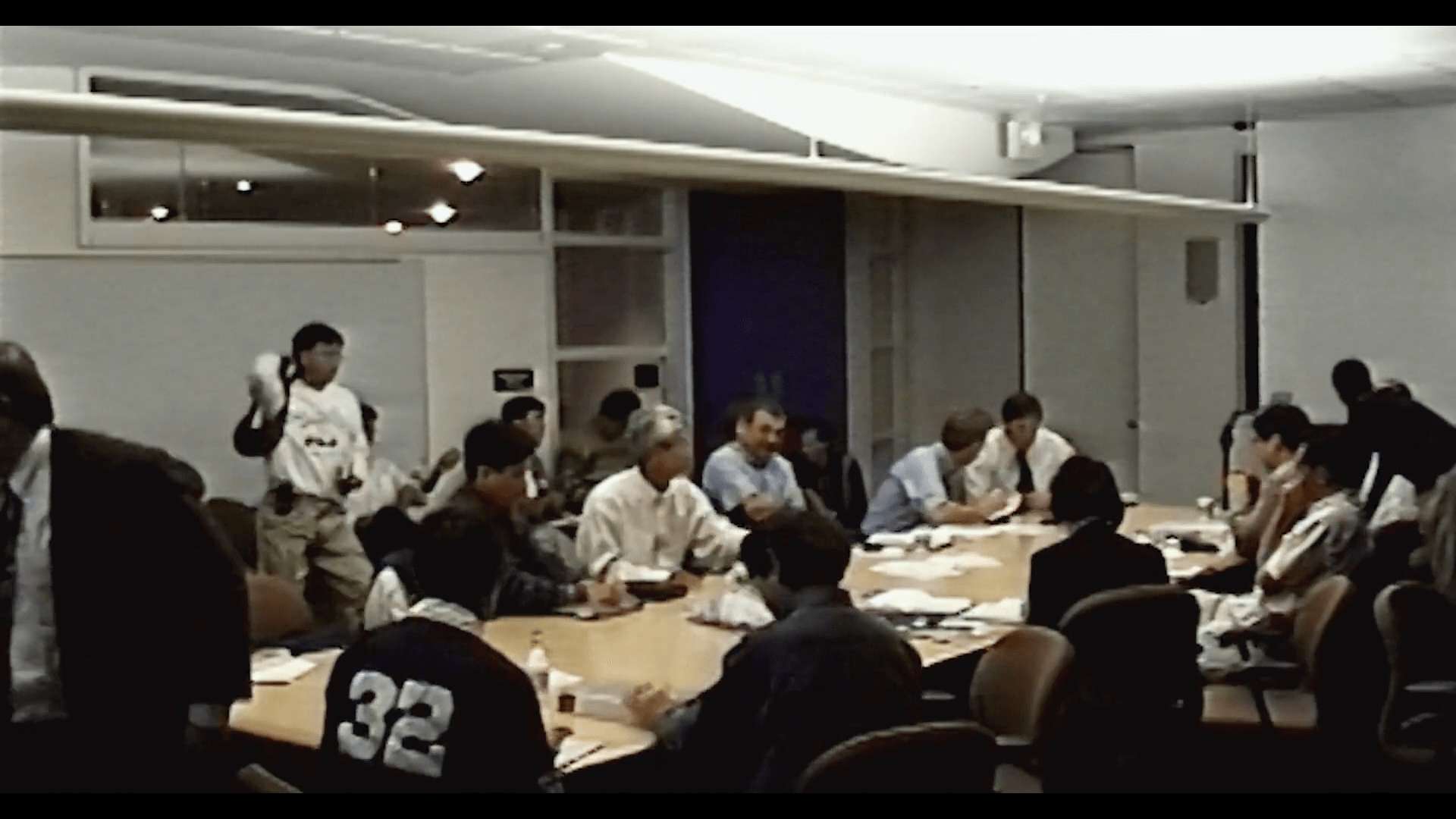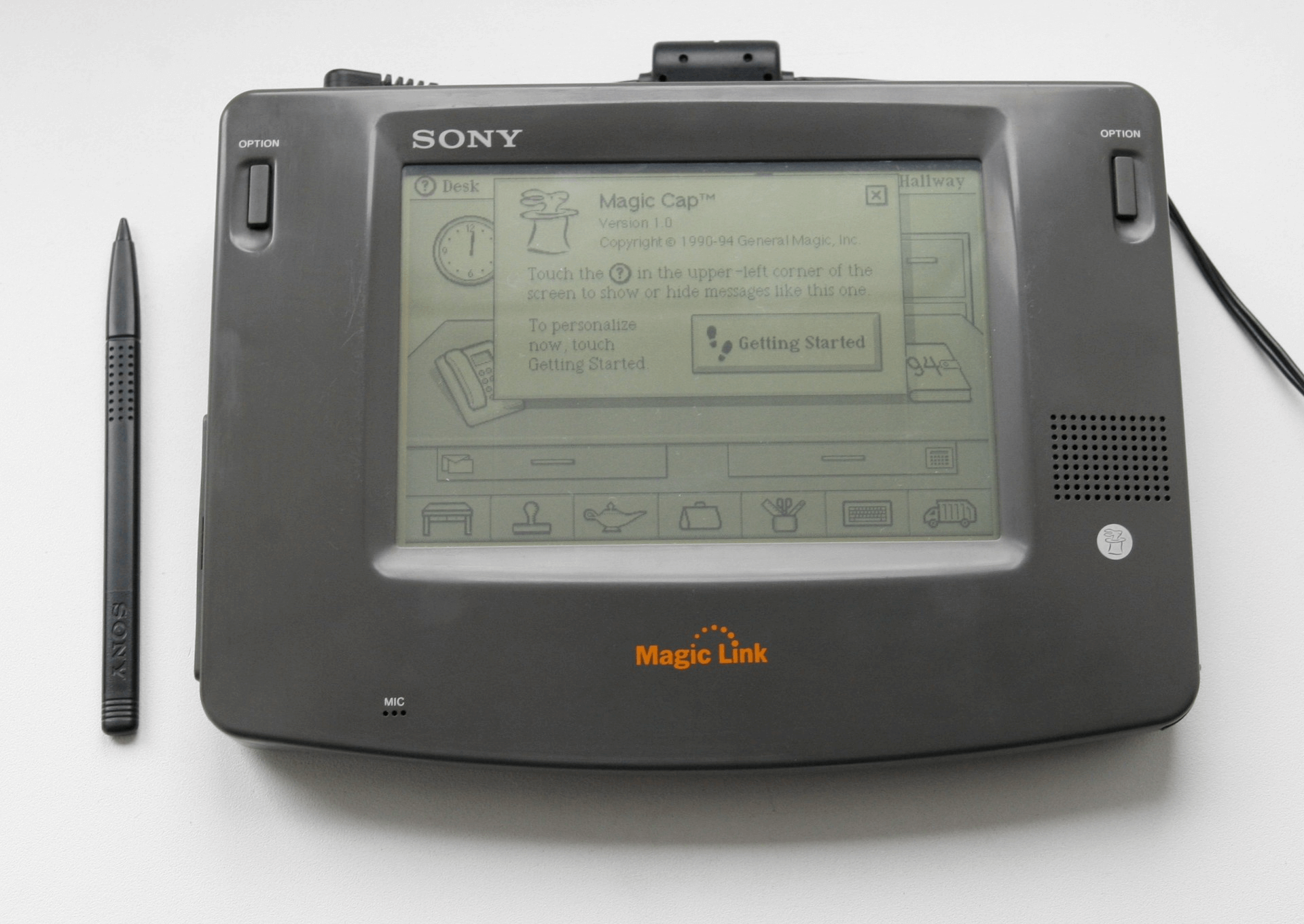Case
General Magic - The Future, Too Early
Tony Fadell built two iPhones. Everyone knows about the second one — Steve Jobs revealed it in a 2007 keynote; that device changed the world forever — but few people know about the first.
In 1989, Apple employee Marc Porat conceptualised what was essentially an early version of the smartphone. The device, named Pocket Crystal, was a touchscreen mobile computer that could one day make calls, fax documents, play games, watch movies, and buy plane tickets.

Image sourced from Build by Tony Fadell.
Porat couldn’t get the resources he needed to develop Pocket Crystal internally, so Apple CEO John Sculley spun off this project as a separate company. And so in 1990, General Magic was born.
Many of the original team members who created the Macintosh signed up — including some legendary personalities such as Andy Hertzfeld, Joanna Hoffman, and Bill Atkinson. The company immediately gained an aura of mystique. Legal counsel Michael Stern said, of the time: “Everybody wanted to be there. And people would literally sleep on the doorstep to try to get an interview or get into the building.”
In 1991, Fadell joined General Magic as a diagnostics software engineer. He was fully committed to the company’s ambitious mission of building the future. He worked 90, 100, 120 hours a week and drank up to a dozen cans of Diet Coke a day to stay awake (he disliked coffee). Fadell later said that he believed he was going to help make one of the most impactful devices in history.
To frame General Magic’s challenge properly, it is helpful to consider the state of technology at the time. Mobile phones were bulky, expensive devices with small screens and large buttons. Pagers were still widely used. Touchscreens were relatively rare. And here was General Magic, proposing to build a mobile computing device using a touchscreen, of all technologies.
Naturally, they had to solve a large number of design and technical challenges.
General Magic’s early years were marked by a wild period of experimentation. Fadell said that whenever interesting ideas popped up, the team would go “wouldn’t it be great if we did that!” One week, the team came up with the concept of having different rooms as a way for the user to navigate the device. Hertzfeld went off and rewrote the system to implement that proposed design over the weekend.

Image sourced from the documentary General Magic.
When Fadell was assigned to build an infrared network between devices (like how a remote control connects to a TV), he reinvented all seven layers of a protocol stack to make it work. He was ecstatic and thought it was a breakthrough. But when a more experienced engineer inspected what Fadell coded, he was baffled. He asked Fadell why he had built a network protocol like that. To which Fadell replied, “I didn’t know I was building a network protocol.”
This was simply part of the culture. As software architect Darin Adler said “we decided to make everything. I mean, we were making it all.” For example, when they were prototyping the Pocket Crystal, none of the touch screens available were good enough. They were too noisy or came with too low a resolution. So General Magic’s engineers invented a new touchscreen. It was balanced on four corner sensors and as the user pushed on the screen, the sensors would measure the change in force and use mathematics to calculate where on the screen the user had touched.
Around the same time, Fadell was experimenting with a technology that would allow him to string peripherals together for the purposes of trying out their prototype. They were unknowingly creating the Universal Serial Bus (USB) before the world caught up with them. Much later, then-General Magic software developer Kevin Lynch said, of the work required:
“In many projects you might build one or two innovative breakout things and then you build on top of a lot of existing stuff. You kind of stand on the shoulders of giants. We weren’t doing that at General Magic. We were building the giant from the toes all the way up to his head (emphasis added).”
The next problem General Magic had to solve was manufacturing and distribution of their product. Their solution: instead of manufacturing everything in-house, they assembled an unwieldy alliance of companies to make and maintain their product. The General Magic Alliance included AT&T, Apple, Motorola, Sony, Panasonic, and Phillips. Some of these companies were natural enemies — Sony and Panasonic, for instance, were deeply competitive in many markets. But they were supposed to work together to help General Magic launch. In reality, these companies and their inter-relationships brought enormous levels of complexity to General Magic.
Years later, General Magic CEO Marc Porat said:
“We were putting sixteen of the largest companies on the planet, who are natural enemies, into the same room at the same time. We knew we were innovating. No one had done anything like that. And if it succeeded, it would change everything. And that took a war-like energy. That was fighting. That was battle.”

Image sourced from the documentary General Magic.
The alliance had an unintended side-effect: it locked them into developing a private network powered by AT&T, just as the internet began to gather steam. At the time, there were multiple competing networks — with the Internet one option amongst many. General Magic employees mostly ignored the alternatives. In public presentations, Porat railed against the emerging world wide web, saying “I have to keep banging on the web with my mouse and my keyboard because unless I do that, nothing happens, the web is passive.” This made sense: after all, General Magic was building a rich multimedia environment powered by AT&T’s proprietary network. The web was a poor medium by comparison. It could only do text and images.
One of General Magic’s tech support engineers, a soft-spoken man named Pierre Omidyar, started an auction service on his personal website. He asked multiple colleagues to check it out, and to help him spin out the service into its own company. All of them rejected him. Omidyar left and turned the website into eBay. So it wasn’t as if General Magic’s staff weren’t aware of the emerging possibilities of the web — one of the dotcom bubble’s most prominent companies was started right under their noses.
To be fair, it wasn’t clear that eBay was going to be a success at the time that Omdiyar left. And General Magic was busy with its own problems — it was, frankly, a mess. The entire company structure was an experiment: there were little-to-no top-down processes, no performance reviews, and few structured meetings. Employees made stuff and went wherever it carried them. Anyone who tried to be a real manager was ignored.
While the company did have a target customer of “Joe Sixpack”, no one took it seriously. It was a bit of a company joke. Engineers simply designed features they liked and assumed that Joe would like it too. Much later, Fadell described Joe Sixpack in his 2022 book Build:
General Magic’s target customer was “Joe Sixpack.” Seriously. It’s a derogatory caricature of an average American slumped on his couch, drinking beer, watching football, not thinking about much of anything. It’s a terrible way to imagine your customer. And even though we repeated it over and over, claimed we were doing it all for him—it was meaningless. Because even if Joe Sixpack existed, he was never going to buy the Magic Link (emphasis added). This was before the internet was remotely accessible, at a time when most people didn’t have a desktop computer, didn’t have email, couldn’t imagine mobile games or movies.
General Magic’s lack of organisation led to multiple product launch delays. When Fadell joined in 1991, the plan was to ship a device in nine months. Then it got delayed by six months, and then by another six months, and yet another six months. This went on for four years, until 1994. And even then, General Magic wanted to delay the launch further, but simply couldn’t.
A year earlier in 1993, Apple had launched Newton, their own mobile computing device. It caught Hertzfeld and the rest of the team by surprise. For the past few years, General Magic had been developing their product in ‘stealth mode’. All work documents were shredded and thrown in separate bins. Employees were told not to discuss work matters outside of the office. The company believed that if their concept leaked, they would lose their competitive edge.
One exception was Apple’s Sculley, who had some access (General Magic had been spun out of Apple, after all; Sculley was on its board). When he launched the Newton at the 1993 Consumer Electronics Show, General Magic’s staff were blindsided. Andy Hertzfeld said, later:
“They were our closest partner, who really gave us our life. And so when we found out they were trying to kill us, we felt completely betrayed.”

General Magic CEO Marc Porat (front left) and Apple CEO John Scully (front right). Image sourced from the documentary General Magic.
When General Magic finally shipped in 1994 — under the threat of Apple’s Newton — they hadn’t made the Pocket Crystal that Porat first dreamed of in 1989. Instead, they released something they called the Sony Magic Link. It weighed 1.5 lbs (0.68 kg) and was priced at US$800 (US$1560 in 2022 dollars). It offered futuristic features like a touchscreen, downloadable apps and animated emojis — the first of its kind. Fadell thought it would be revolutionary — people could now carry a personal computer with them wherever they went.
But nobody bought it.

Image source.
In the end only three to four thousand Magic Link devices were sold, and mostly to family and friends. Fadell said that it crushed him. By this point he was no longer a lowly diagnostics software engineer. Over the course of the device’s development, from 1991 to 1994, Fadell ventured out and worked on all the different parts of the device: silicon, hardware, software architecture and design. He talked to the sales & marketing team, learned about branding, and grasped the importance of managers. But the device was a huge failure and he thought it was his fault.
Fadell believed he had learned a few key lessons from the experience. While General Magic was making incredible technology, it wasn’t making a product that would solve real people’s problems. Fadell pitched an idea to pivot and make devices for business people instead. In Build, Fadell wrote, of the proposal:
They [business people] were beginning to use email and notes and digital calendars. They needed all their contacts on a mobile device instead of on a ten-pound laptop. They were like my dad—always on the move from city to city. And they were constantly rushing out of cars and planes to feed quarters into pay phones to listen to their voicemails, trying to make deals and catch meetings in an era before cell phones. They had a problem we could solve.
It was so glaringly, wonderfully obvious. Make a product for people who already saw the need and felt the pain daily. Just take the Magic Link and put a keyboard on it. Strip out the quirks and whimsy—kill the walking lemons [an emoticon the team had invented]—and focus on work (emphasis added).
But General Magic’s management killed the proposal. Too many things would need to change. Fadell would leave soon after, in 1995, to go work with Philips to develop his idea of a business-oriented mobile computer. Eventually, he would end up working at Apple, helping to create their iPod and iPhone products and eventually go off to start Nest Thermostats.
Meanwhile, General Magic would continue on its downward spiral. From 1990 to mid-1996, the company lost more than $74 million dollars. In 1999, its stock price declined to $1.38 even though this was at the height of the dot com bubble. The same year, they announced layoffs and missed projections. They would eventually shut down operations in 2002.
Questions
Compare this case with a previous case you've read. What is similar? What is different?
Does this remind you of a similar case? If so, what is different there?
If you have any thoughts, feel free to comment in the member's forum.
Sources
Build by Tony Fadell. Published in 2022.
General Magic (documentary). Released in 2019.